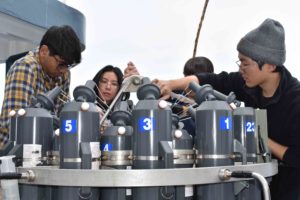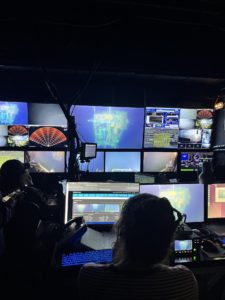
August 8, 2025
It is hard to believe that it has only been four days since the R/V Atlantis left port. So much has happened that it has felt like we have been out much longer. This is due to our around-the-clock operations – there is always something happening and people are always up and working, which also means there is consisstently someone sleeping. The tasks that fill our 24 hours include running and logging Jason dives, deck work to prepare equipment for deployment and inspecting equipment that has been recovered, water sampling, and chemical analyses of the fluids that are used for validating instruments on the array. Our team of scientists, engineers, and students do all these tasks with smiles and enthusiasm. The students especially are eager and excited to assist with any operation they can.

Their excitement and wonder at each experience – new to them, but sometimes very old hat to those of us onboard – is a wonderful reminder of the joy that being at sea brings to us all and reminds us, in part, why we do what we do. The excellent meals cooked by the stewards aboard the R/V Atlantis provide a morale boost for all.
The first three days of Leg 1 felt particularly fast paced due to our focus on the three Shallow Profiler moorings and their assemblies (consisting of an instrumented stationary platform and an instrumented winched profiler, which in total can host up 18 instruments). These six packages were turned in rapid succession at the Oregon Offshore, Slope Base and Axial Base sites – no small feat since each profiler turn consists of three separate Jason dives. Every member of the team contributes to these operations. The APL engineers complete final testing and calibration on the instruments, stationary platform, and winch controller. The VISIONS’25 students are instrumental during the dives serving as loggers in the ‘mission control’ style Jason van. The students also assist with the CTD water casts that accompany the profiler swaps. The casts are led by RCA research scientist, Mariela White, and on this Leg have been conducted before the dives. Samples are taken to measure the salinity, chlorophyll, oxygen, nutrients, and dissolved carbon and are compared to data from the recovered sensors to assess if they have drifted during their deployment over the past year. On Leg 2, will take samples to provide comparison data for the instruments deployed during this leg. VISIONS’25 students help by deploying and recovering the CTD rosette on deck, helping to collect the samples, and assisting in the lab with analysis.
Unlike most years, we still have one Shallow Profiler Science Pod to deploy at Slope Base. While we typically do these three dives together for a total of nine, we have only done eight so far. This year, a component from the previously deployed Science Pod is being repurposed for the new Science Pod to be deployed in a day or so. Instead of rapidly reinstalling the new Science Pod at Slope Base, we have kept both the 2025 and 2025-2025 Science Pod with us as we transited 18 hrs to Axial Seamount to conduct our work. The component swap involves the APL engineers doing work on the back deck of the R/V Atlantis, which is normally done onshore in the lab prior to the cruise. These efforts include removing, cleaning, and installing the 2024-2025 Science Pod and thoroughly testing its power and communication. The elements – wind, rain, and waves – add an extra level of excitement to these tasks, but the engineers have everything they need onboard to complete the work as if they were back on shore.

This swap also means that we still have one more dive at a Shallow Profiler Mooring planned for this year, so if you are interested in seeing these impressive two-legged moorings live, tune into the upcoming Slope Base dives. The state-of-the-art, one of a kind moorings in the oceans host two legs that go 3000 m to the seafloor and which connect at 200 m below the surface to a 12 ft across, 5,000 lb platform. The two legs keep the platform in place so that it cant do “donuts” in the ocean currents, which would result in breaking the fiber optic cable on one of the legs that transmits real-time data from all of the engineering and science instruments on the mooring to shore at the speed of light. We then swap the platform interface controller and science pod assemblies – sometimes called “saddlebags” – with the ROV. The platform controller and science pod collect data on the temperature, salinity, oxygen, pH, nutrients, chlorophyll and more between the 200 m platform and ~ 5 m beneath the oceans surface, providing a comprehensive view of physical and chemical water column phenomena. Having made >>50,000 profiles, they provide unparalleled insight into processes operating along the Cascadia Margin and 300 miles offshore at Axial Seamount.
